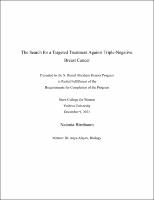Please use this identifier to cite or link to this item:
https://hdl.handle.net/20.500.12202/7894| Title: | The Search for a Targeted Treatment Against Triple-Negative Breast Cancer |
| Authors: | Alayev, Anya Birnbaum, Natania |
| Keywords: | breast cancer targeted treatment triple-negative breast cancer |
| Issue Date: | 9-Dec-2021 |
| Citation: | Birnbaum, N. (2021, December 9), The Search for a Targeted Treatment Against Triple-Negative Breast Cancer, (Undergraduate honors thesis, Yeshiva University). |
| Series/Report no.: | S. Daniel Abraham Honors Student Theses;December 9, 2021 |
| Abstract: | Breast cancer is the most common type of cancer worldwide, having surpassed lung cancer in 2020. It is the most common type of cancer to affect women in almost every country, and can and does occur in males, but more rarely. It is also the most common cause of death by cancer among women worldwide, and in the United States, it is second only to lung cancer. (1) Incidence rates rose sharply in the 1980s and 1990s, most likely due to more widespread mammographic screening, but dropped in the early 2000s, due at least in part to reduction in hormone replacement therapy in menopausal women. (2) According to the data from the 2018 SEER cancer survey, there is a 1 in 8 chance that a woman will be diagnosed with breast cancer in her lifetime, and once diagnosed, a 1 in 39 chance that she will die from it. (3) The American Cancer Society estimated that in 2019, over a quarter million new cases of breast cancer were diagnosed in the US alone. (4)¶ The risk of disease for each individual is different, and is affected by many factors. According to the American Cancer Society, the factors that increase breast cancer risk the most are the presence of a mutation in the BRCA genes, being older than 65, pre-existing hyperplasias or carcinomas in the breast, and high levels of estrogen post-menopause. (5) The prognosis for individuals diagnosed with breast cancer is also affected by these factors, as well as how advanced the disease is when it is diagnosed. If breast cancer is diagnosed before it metastasizes outside the immediately surrounding tissue, the patient has a much better chance of surviving longer than if the cancer had already spread throughout the body.¶ The types and arrangements of cells in the tumor also play a large role in prognosis. Breast cancers are often categorized by molecular subtype, based on what receptors and enzymes are expressed in the cells. The presence of these distinct molecular markers affects how the cells behave, including how and where they metastasize, and what treatments can be used against them. |
| Description: | Undergraduate honors thesis / Open Access |
| URI: | https://hdl.handle.net/20.500.12202/7894 |
| Appears in Collections: | S. Daniel Abraham Honors Student Theses |
Files in This Item:
| File | Description | Size | Format | |
|---|---|---|---|---|
| Natania Birnbaum - Honors Project OA 9Dec22 Breast Cancer.pdf | 693.08 kB | Adobe PDF |  View/Open |
This item is licensed under a Creative Commons License

